
If you're new to the sport of bowling, you might be curious about the significance of a strike and how it impacts your game. Bowling may seem like a simple game of just hitting the pins, but keeping score can be confusing. From understanding the scoring system to perfecting your technique, we've got you covered.
Many people are unsure of how much a strike is worth and what it means to their overall game. If you're one of those people, don't worry! In this article, we'll explain everything you need to know about how much is a strike in bowling and more to help you improve your bowling game.
Contents
- 1 How Much Is a Strike in Bowling?
- 2 What Is a Strike?
- 3 How to Bowl a Strike - Step by Step
- 4 Why Are Strikes Worth More Than Spares in Bowling?
- 5 How Many Points Are 2 Consecutive Strikes in a Row?
- 6 How Many Points Are 3 Strikes in a Row?
- 7 Why Are 3 Strikes in a Row Called a Turkey?
- 8 What Is a Perfect Game in Bowling?
- 9 What Is the Highest Bowling Score Possible Without a Strike?
- 10 Other Names/Nicknames for Consecutive Strikes
- 11 The Key to Getting a Strike Every Time
- 12 How Scoring is Done
- 13
- 14 Related Articles
How Much Is a Strike in Bowling?
Ten Pin Bowling
In 10-pin bowling, a strike is worth 10 points PLUS two additional or bonus points rolls (throws). The max points received in any one frame is 30. If you don’t get strikes from the bonus rolls, the score will be 10, plus the number of pins knocked down of the following two rolls.
Five Pin Bowling
In 5-pin bowling, if all five pins are knocked down on the first roll, this is called a “strike,” and 15 points PLUS 2 more rolls on that frame. You can get 45 points in the frame if you bowl 2 more strikes with the 2 bonus rolls. If you don’t get strikes from the bonus balls, the score will be 15 plus the score of the following two shots.
*note- the dashes "-" in frame 1 represent each bonus roll*

What Is a Strike?
A strike in both 10 and 5-pin bowling happens when a player knocks down all of their pins on the first try; that's considered a strike. Also, on the scoreboard, there should be an X.
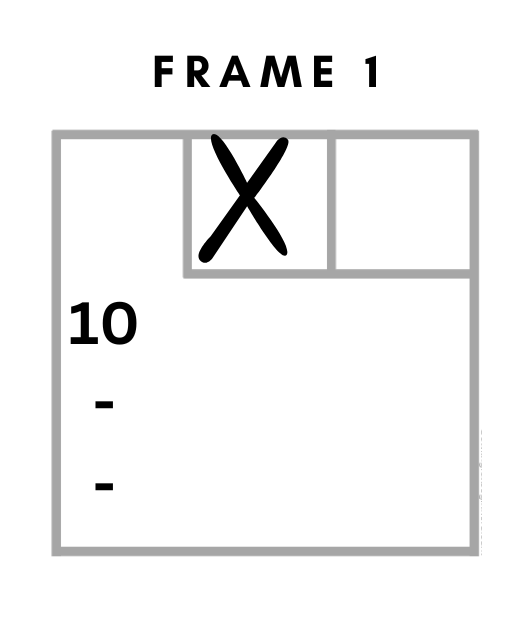
How to Bowl a Strike - Step by Step
Bowling a strike isn't hard. It will probably happen at least once in a game. However, this problem becomes when you want to bowl strikes consistently. The consistent part is where the struggle and frustration lay.
Striking consistently requires some understanding of the ball, the lane, oil patterns, approach, and release, to name a few. And we want to touch on the approach and release.
Step 1: Find a starting position
Place your left foot in the middle of the dots on the ground. If you are left-handed, do the opposite.
Step 2:Locate the target.
Aim to throw the ball on the right-hand second arrow. The ball will have greater traction as it glides down the lane if it's thrown to the right of the arrow. For left-handers, do the opposite.
Step 3:Keep an eye on where your shot falls.
Keep track of where the ball goes and how it enters the pocket. This will assist you in preparing for your next shot. Depending on the conditions of the lanes you're playing on, many techniques will need to be adjusted.
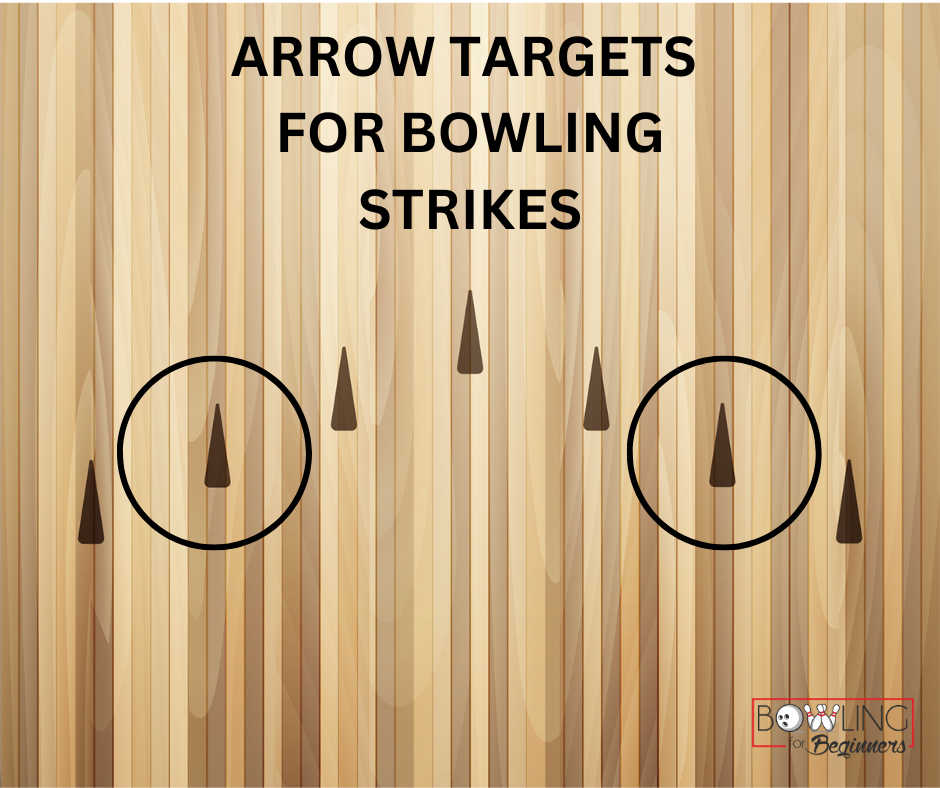
Why Are Strikes Worth More Than Spares in Bowling?
How much is a strike worth? Strikes are worth 10 points, plus the pins knocked down in the next two rolls. Those rolls could happen in the following frame if you do not strike. Or, the bonus rolls could happen in the next two frames when you strike in both bonus frames.
Spares only gain you a single bonus equal to only the first ball you throw after the spare is made. The value of the second roll after a strike is the difference in value between a strike and a spare. This bonus, the third shot (original strike, roll 1, and roll 2) in the whole sequence, boosts scoring averages closer to the elusive perfect 300 mark.

How Many Points Are 2 Consecutive Strikes in a Row?
When two consecutive strikes are rolled, the math is calculated differently. Instead of 10 points, that's 20 points in the first frame (the original strike + the 2nd strike) plus the number of pins the bowler knocks down in the third period. Calculating points for Frame 3:
20 points are carried forward from frame 2. The first 10 points in Frame 3 are the original strike. The 2nd 10 points are from the strike in Frame 4 (1st bonus roll). The 3rd 10 points are from the 2nd strike in frame 5. When all the points are added together, Frame 3's total is 50 points.

How Many Points Are 3 Strikes in a Row?
Three consecutive strikes will earn you 30 points in the first frame. In the second frame, it's the same as scoring for a double, whereas in the 3rd frame is like scoring for a strike.
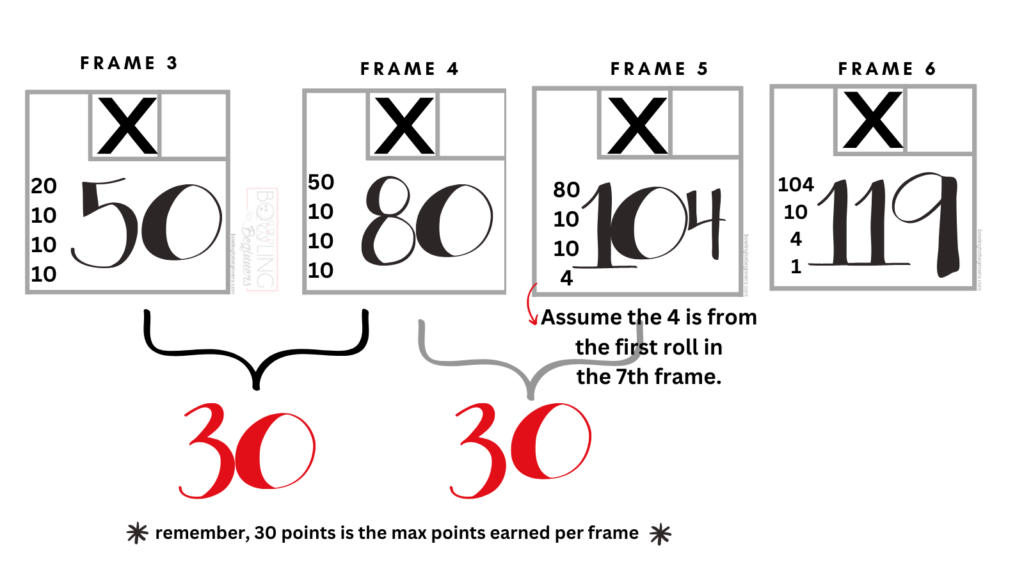
Why Are 3 Strikes in a Row Called a Turkey?
Bowling folklore has it as originated as a reward in a bowling event. Basically, prizes that were given out during these games in the late eighteenth and early nineteenth centuries were frequently food items, such as a basket packed with various grocery items, a huge ham, or the like.
Turkeys became popular prizes in the United States, especially around Thanksgiving. One event decided to give out a turkey to those who bowled multiple strikes (three strikes) in a row at some point (no one knows when this happened for the first time). Long after genuine turkeys were no longer given away, this practice spread and became part of conventional bowling jargon.
What Is a Perfect Game in Bowling?
The maximum score for ten pin bowling is 300 points for a perfect game. This is accomplished by bowling 12 consecutive strikes in a single game, with a strike in each of the first nine frames and three more strikes in the tenth frame.
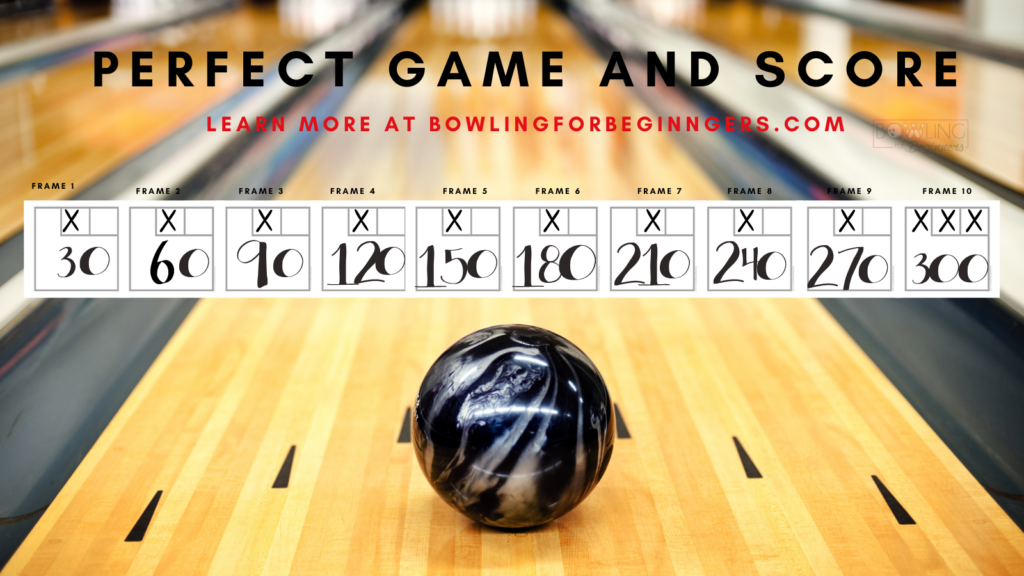
What Is the Highest Bowling Score Possible Without a Strike?
You can achieve a total score of 190 points if you play a game where you don't throw any strikes but get your spares. To accomplish so, you'll need a spare in each frame. You must knock down nine pins and then gain a spare by knocking the final pin to get this score. You must knock over nine pins in the tenth frame, then knock the single pin left over, and finally knock nine pins with your third roll.
Other Names/Nicknames for Consecutive Strikes
There exist different and unique nicknames for getting consecutive strikes in bowling. The following are the nicknames:
- It's a double if you get two strikes in succession.
- The term "turkey" or "triple" refers to three strikes in succession.
- A four-bagger or hambone is when you get four strikes in succession.
- Five consecutive strikes are known as Yahtzee or Five-bagger.
- Six consecutive strikes are referred to as a "six pack" or "six-bagger."
- Seven consecutive strikes are known as a Front Seven or Seven-bagger.
- Eight consecutive strikes are known as a Front Eight or Eight-bagger.
- Nine strikes in a row, often known as a "Front Nine" or "Nine-bagger."
- Front Ten or TenBagger is two terms for 10 consecutive strikes.
- Front Eleven or Eleven Bagger refers to 11 consecutive blows.
The Key to Getting a Strike Every Time
Everyone wants to bowl a strike while they're out on the lanes, whether they're an aspiring pro, a casual hobbyists, or just someone going to the bowling alley for a group date. There's nothing like hearing those 10 pins smash down and turning around to hear your buddies or teammates congratulate you on a job well done to top it off.
There are ways that can elevate you to that level where you’re the monster when it comes to bowling. They exist the following;
1. Choose the Right Ball
The selection of the proper bowling ball is one of the most critical aspects of learning how to bowl a strike. You might think that going for sheer power and choosing the heaviest ball you can throw is the best method, but that isn't the case.
The truth is that you should choose a lighter ball since it’ll be simpler to control and will cause the pins to collide instead of shooting up into the air.
2. The Approach
The way you approach the lane will determine whether or not you receive a strike. The pros do it like this: Start with the foot opposite your throwing hand and take four steps. Maintain a straight line while walking with your eyes on the target arrow.
The second arrow from the right will be your target arrow for right-handed bowlers, while the second arrow from the left will be your target arrow for left-handed bowlers. Slowly and steadily approach, making deliberate movements.
3. Get Into Position
Your stance and positioning are important aspects of how to bowl a strike. With a modest bend in your knees and your feet slightly apart, your stance should be straight and upright. Holding the ball on the same side of your body as your bowling hand is a good idea.
For a natural swing, keep the arm relaxed. Keep your arm straight and close to your body on the backswing. Consider the swing as a pendulum.
4. Get The Right Timing
When it comes to bowling a strike, the timing of your release is crucial. Just as your swing reaches its lowest point, by your feet, release the ball. You'll avoid dropping the ball onto the lane (which occurs when you release too soon) or lofting the ball this way (which happens if you release too late).
5. Hit The Pocket
The pocket, which is the space between the first ball and the three-pin for a righty or the two-pin for a lefty, is your target for how to get a strike. You'll have to curve the ball a little to get it there. As you release the ball, rotate your thumb to a 10 o'clock position, or a 2 o'clock position if you're left-handed, to give the ball some spin.
How Scoring is Done
A player is awarded ten points plus a bonus of whatever is scored with the next two rolls if all ten pins are knocked down with the first ball roll (called a strike and commonly depicted as an "X" on a score sheet) (not necessarily the next two frames).
As a result, the points earned for the two rolls following the strike are doubled.
Frame 1, ball 1: 10 pins (strike)
Frame 2, ball 1: 4 pins
Frame 2, ball 2: 5 pins
The total score from these throws is:
- Frame one: 10 + (4 + 5) = 19
- Frame two: 4 + 5 = 9
TOTAL = 28
Score the strike for a flat 10 points and then add 1 to the multiplier of the next two rolls for an easier non-standard method of scoring a strike. As a result, the scoring in the preceding example would be as follows:
- Frame one: 10
- Frame two: (4 x 2) + (5 x 2) = 18
TOTAL = 28
Strike scoring is similar to that in five-pin bowling, with the exception that strikes are for 15 points instead of 10 (as the pins are scored with the values of 2, 3, 5, 3, and 2).
How Is a Spare Scored in Bowling?

Spares are 10 points plus the next roll.
A player who gets a spare gets 10 points plus the additional points from pins knocked down on their very next roll (only the first ball is counted).
What Happens if I Can’t Knock Down All Ten Pins in a Frame?

The frame is considered open, and you will only earn points for the pins that were knocked down.
An open frame occurs when a player fails to knock down all 10 pins after their second ball. A "spare" is awarded when the pins do not fall into place after a frame is shot.
What Is a Bad Bowling Score?

As a casual bowler, anything less than 70 points can be considered "bad".
It’s when you score a game with less than 100 points. More than that is possible for a beginner who takes the game seriously.
What Is a Good Bowling Average?

Depending on your level: casual bowler, 70-100 points. Non-league 130-170. For league bowlers, 175-195 points in a game, and for professional bowlers, 200-250.
As you can see, a good bowling average greatly depends on your bowling skill level. Don't judge yourself too harshly if your numbers are below average. Use it as a benchmark to improve as you practice.
How Often Do Pro Bowlers Bowl a 300 Game?
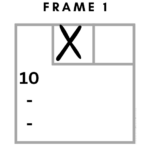
A tour player has a chance of 3,000 to 1, and a low-handicapper has a chance of 5,000 to 1.
Similar to making an ace, the higher your bowling skills are, the more likely you are to bowl a 300 game. A PBA bowler's chances of rolling a 300 are 460 to 1, compared to 11,500 to 1 for the typical bowler.
Related Articles
Each game of bowling consists of ten frames with numerous extra bonuses. Each shot stands alone, but when bonuses are included, they can add up to a lot of points. Don't worry if you're still unsure about how to score in bowling. That's not unusual.
Once you factor in all the rules of the game, garnering points will be your norm.
Kira Byrd, a Certified Fraud Examiner, holds a B.S. in Accounting from the University of Alabama at Birmingham. With a passion for bowling from her childhood, Kira has poured her expertise and personal experiences into creating and nurturing Bowling For Beginners. Kira's mission is to meet new bowlers where they are and guide them toward consistently achieving higher scores. With a focus on skill development and strategic techniques, she empowers readers to take control of their game and unlock their true potential.
Bowling For Beginners embodies strict editorial integrity, ensuring reliable and unbiased information. Kira's commitment to delivering valuable insights and practical strategies is reflected in every article. Here's an explanation of our editorial policy and how we get money.





